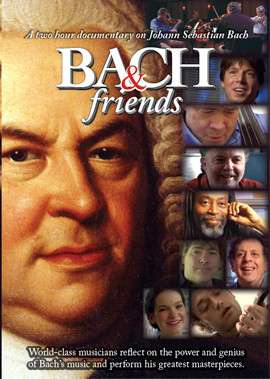|
Back
03/31/2011
Michael Lawrence: Bach & Friends
Joshua Bell (violin), Bobby McFerrin (voice and conductor), Philip Glass (composer), Béla Fleck (banjo), Hilary Hahn (violin), Emerson String Quartet, Edgar Meyer (double bass), Manuel Barruceco (guitar), Chris Thile (mandolin), Simone Dinnerstein (piano), Jake Shimabukuro (ukulele), The Swingle Singers, John Bayless (piano), Matt Haimovitz (cello), Peter Schickele (composer), Richard Stoltzman (clarinet) , Zuill Bailey (cello), Sid Meier (computer programmer), Joao Carlos Martins (piano), Felix Hell (organ), Mike Hawley (piano), Uri Caine (piano), Tim Page (critic), Charles J. Limb (M.D.), Hilda Huang (piano), Anatoly Larkin (piano), John Q. Walker (Zenph Studios), Harlan Brothers (inventor, mathematician and musician), Andrew Talle (cello), and Christoph Wolff (musicologist)
Recorded live by Michael Lawrence at various locations (2010) – 206’ (2 DVDs)
Produced by Michael Lawrence Films - Ref. #: 0487915489 – Picture format: Not provided – Colour mode: Colour – Region Code: 0 – Stereo – Subtitles in English, Spanish, German, Italian, and Japanese – No liner notes

Bach & Friends is a marvel. In just under two hours, over 30 individual musicians, as well as the Emerson String Quartet, paint a loving and in-depth tableau of the life and music of Johann Sebastian Bach. It is a contemporary love letter to Bach. No one should doubt, after watching this film, that J.S. Bach was the greatest composer who ever lived.
Artists contributing to this homage range from the 12-year-old pianist Hilda Huang (who also teaches!), to Bobby McFerrin, to Joshua Bell, and to Philip Glass. Instruments include the voice, lute, cello, glass harp and the computer. Styles explored include religious, jazz, blue grass and scat.
Most of the guest artists offer either their personal experiences with Bach, or focus on his life and works while, or before, performing one of his compositions. The pianist Mike Hawley (who provides much of the narrative) reminds us not to see Bach only as a supreme genius, but to look at his human side as well – the joy and tragedies of his life that enormously affected his music. Bach’s mother died when he was 10. His father when he was 11. He married his cousin Maria Barbara at 22. Their twins were born and died when the parents were 28. His wife then died at 35, while he was away from home, leaving him with seven children! He did remarry, but these traumatic life experiences must have had an enormous impact on his work.
Bach’s musical accomplishments are illustrated with enough details to satisfy the seasoned adult as well as the beginner. We are told that Bach didn’t compose – he couldn’t have had the time – that he just wrote down what he heard in his head. Also emphasized are his genius for improvisation, the infinite possibilities he opened up for harmony and counterpoint, and the spiritual and cosmic planes to which his music aspires.
Two of his masterpieces figure prominently, and rightly so – The Goldberg Variations and The Art of the Fugue (a selection of the latter passionately rendered by The Emerson String Quartet).
The future is represented as well. One vignette features pianist John Bayless playing a keyboard while undergoing a brain scan. This illustrates how areas of the brain respond differently to music played from memory than to musical improvisation. Another section illustrates how original recordings can be digitized and replayed on an instrument without the musician being present. Glen Gould would have loved this!
The narrative tracing Bach’s development is well woven into the musical examples. The performances are heartfelt, sincere and moving. The recorded sound and images exemplary. It would have been nice, however, to know in what locations (some in churches, some in skyscrapers overlooking New York City) the performances and commentary are taking place.
In addition, a 90-minute bonus DVD gives complete performances of all the pieces (or parts thereof) used as illustrations in the film. At its conclusion, Joshua Bell gives his first recorded rendition of Bach’s “Chaconne”, the last movement from his Partita in D Minor for Solo Violin.
The most serious omission in the film is Bach’s choral work. The Swingle Singers do sing a lustful and jolly “Badinerie” from his Orchestral Suite No. 2 in B minor. I understand, however, that the film was produced on a shoestring budget, and that “Part 2” is imminent. If so, it would be interesting to hear from some choral directors and conductors. Also, liner notes and performance timings (particularly on the bonus DVD) would be welcomed.
The Michael Lawrence Films Website
Earl Arthur Love
|